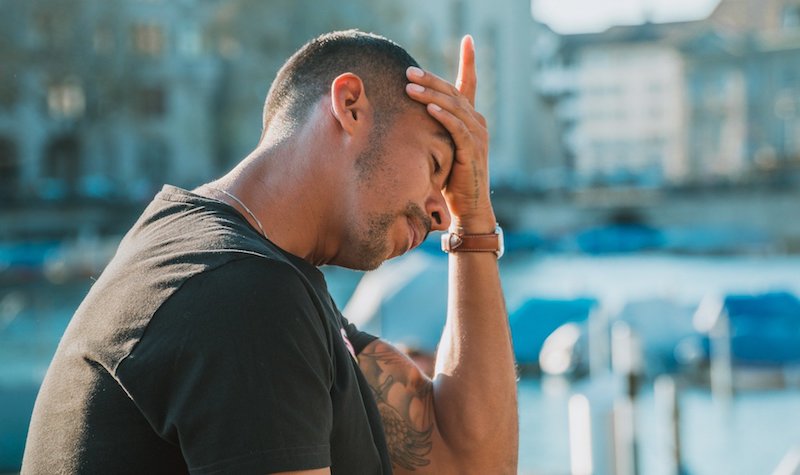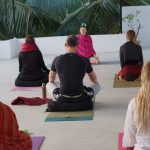Anxiety is a normal part of life. It often happens in new or important situations, such as taking a big test at school, giving a presentation at work, or making a life-altering decision. Many times the worry or fear passes as soon as the situation is over. But if those feelings stick with you or worsen over time, it could be a sign of an anxiety disorder.
There are several types of anxiety disorders. One of these is called generalized anxiety disorder. This involves excessive anxiety or worry about activities or events, with those feelings occurring on most days and lasting for at least six months. An estimated 2.7 percent of American adults — and 2.2 percent of adolescents — had generalized anxiety disorder in the past year.
One of the most common treatments for generalized anxiety disorder is cognitive behavioral therapy, a type of psychotherapy. This technique helps people learn new ways of thinking about or reacting to objects and situations that make them anxious or fearful. In yoga terms, cognitive behavioral therapy helps people develop new patterns, or samskaras.
One of the key aspects of traditional yoga, especially as described in the classic text the Yoga Sūtras of Patañjali, is the observation and shifting of our patterns, which includes our thoughts, behaviors, and emotions. When we are able to change our patterns, it becomes easier to come into a state of yoga — defined by Patañjali as the capacity to direct the mind in a direction of our choosing. This, in turn, helps us see objects and situations more clearly, including those that make us anxious or fearful.
However, while yoga can be a great tool to help you deal with everyday anxiety, it’s not clear whether it can relieve the more serious symptoms experienced by people with generalized anxiety disorder.
That’s why a group of researchers from the NYU Grossman School of Medicine in New York City, Brigham and Women’s Hospital in Boston, and other institutions set out to see how well yoga works as a treatment for generalized anxiety disorder.
The results were published August 12 in the journal JAMA Psychiatry.
Study compares yoga for anxiety to psychotherapy
In the study, researchers used Kundalini yoga, a style developed by Yogi Bhajan in the 1960s. This type of yoga involves a mix of yoga theory, philosophy and psychology, physical postures and exercises, breathing techniques, meditation, and deep relaxation practices.
Researchers randomly assigned 226 adults diagnosed with generalized anxiety disorder to do 12 weeks of Kundalini yoga, cognitive behavioral therapy, or stress education. People in each intervention participated in weekly two-hour sessions, with three to six participants and two certified instructors in each group. Everyone was also asked to do 20 minutes a day of homework related to their in-person classes.
Immediately following the 12-week program and at a six-month follow-up visit, researchers measured whether or not people had responded well to the treatment they were doing. They used this to calculate response rates — what fraction of each treatment group responded well. They also measured participants’ mindfulness throughout the study.
Only 155 people completed all of the assessments during the study, and 137 people did the six-month follow-up visit. Completion rates were similar for all three interventions.
The most common reason people gave for dropping out of the study early was difficulty fitting the weekly sessions into their schedule. Few people, though, dropped out because they were not happy with the treatment.
Researchers found that group cognitive behavioral therapy (CBT) was more effective at reducing people’s symptoms than the stress education class, both at the end of the treatment program and at the follow-up visit.
Kundalini yoga was also more effective than the stress education class, but only immediately following the program, not at the six-month follow-up. However, Kundalini yoga was less effective than CBT.
The researchers write that this confirms that CBT is effective as a first-line treatment for generalized anxiety disorder. In addition, “the available literature and our data support that [Kundalini yoga] may be a helpful but only moderately potent intervention for [generalized anxiety disorder],” the authors write.
These results fit with an earlier study which found that women with generalized anxiety disorder had lower levels of anxiety after eight weeks of Kundalini yoga. It’s also in line with other research suggesting that mindfulness-based programs that include gentle Hatha yoga practices may be beneficial for people with anxiety.
Other studies have also shown that yoga can improve mindfulness. The authors of the new study thought this might be the reason for yoga’s beneficial effects on people’s anxiety symptoms. But that’s not exactly what they saw in this study.
People who started the 12-week program with greater mindfulness responded better to the interventions, regardless of which one it was. In addition, all three interventions had similar effects on people’s mindfulness over the course of the study.
The researchers write that this may be due to Kundalini yoga focusing on a single object, such as the breath or a mantra — a more focused type of attention. Another type of yoga might have a larger effect on overall mindfulness, such as the open-focus mindfulness that is emphasized in Kripalu yoga.

Yoga offers other physical and mental benefits
In spite of Kundalini yoga being less effective than CBT for anxiety, yoga offers several benefits over psychotherapy. People with anxiety may not have access to mental health treatments, either due to a lack of insurance coverage or because those services aren’t offered in their area. People with anxiety may also feel more comfortable going to a yoga class than to a group or private therapy session.
Traditional yoga’s mix of physical postures and exercise, breathing exercise, relaxation, and meditation and mindfulness exercises can also help shift the body from “fight or flight” mode (sympathetic nervous system) to “rest and digest” mode (parasympathetic response). If you’ve ever taken a restorative yoga class, you might have already experienced this feeling.
However, this doesn’t mean that yoga is a substitute for mental health care. If your anxiety symptoms are severe enough that they are affecting your daily life, you should seek help from a mental health professional. They can help diagnose your condition and rule out other disorders such as depression or panic disorder.
Once you have that in place, you can give yoga a try — it might even work well alongside CBT or other treatments for anxiety. However, here are a couple of things to keep in mind.
The new study showed that the benefits of yoga for anxiety seem to decrease once people stopped taking group yoga classes. However, the study doesn’t show whether they continued to practice yoga on their own after the 12-week program ended. But the results suggest that regular yoga is needed to maintain the benefits for anxiety.
Also, not all types of yoga are the same, which means not all of them will have the same effect on anxiety symptoms (some yoga practices might even make your anxiety worse). This study used a specific Kundalini yoga program designed for people with anxiety. It may not be available in your area, but there are other types of yoga for anxiety programs. So look for a yoga teacher who has been specifically trained to help people with anxiety.
12-week Kundalini yoga program for anxiety
The authors of the new study described in an earlier study the Kundalini yoga program that they used as a treatment for generalized anxiety disorder.
It consists of weekly two-hour sessions over 12 weeks, with 20 minutes of daily homework. The program includes a mix of yoga theory, philosophy and psychology, physical postures and exercises, breathing techniques, meditation, and deep relaxation practice. Group practices vary each week, but increase in intensity over the course of the program.
Here are some of the components of the program, many of which can be found in the The Yogi Bhajan Library of Teachings:
- Breath practices: Sitali Breath, Alternate Nostril Breathing, Pauri Kriya
- Hour-long Kundalini yoga sets/series: Basic Spinal Energy Series, Calmness and Anti-anxiety Series, Stress Set for Adrenals and Kidneys
- Individual yoga meditations with coordinated breathing: Segmented Breath for Anxiety, Tattva Balance Beyond Stress and Duality, Shabd Kriya
The 20-minute daily home practice consisted of the following:
- Seated spine flexes forward and back (1 min)
- Seated spinal twists (2 min)
- Shoulder shrugs (2 min)
- Neck rolls in both directions (2 min total)
- Cat-cow spinal flexes on the hands and knees (2 min)
- Segmented Breath for Anxiety: segmented inhales in 4 parts followed by segmented exhales in 8 parts maintaining a 1:2 ratio between the duration of the inhales and the duration of the exhales (11 min)








You are such a talented writer! I am so grateful to have found your work. Very interesting & inspiring!
Namaste,
Hope
Thanks. I’m glad you’re enjoying my writing.
Namaste,
Shawn